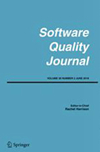The aims of the Software Quality Journal are:(1) To promote awareness of the crucial role of quality management in the effective construction of the software systems developed, used, and/or maintained by organizations in pursuit of their business objectives.(2) To provide a forum of the exchange of experiences and information on software quality management and the methods, tools and products used to measure and achieve it.(3) To provide a vehicle for the publication of academic papers related to all aspects of software quality.The Journal addresses all aspects of software quality from both a practical and an academic viewpoint. It invites contributions from practitioners and academics, as well as national and international policy and standard making bodies, and sets out to be the definitive international reference source for such information.The Journal will accept research, technique, case study, survey and tutorial submissions that address quality-related issues including, but not limited to: internal and external quality standards, management of quality within organizations, technical aspects of quality, quality aspects for product vendors, software measurement and metrics, software testing and other quality assurance techniques, total quality management and cultural aspects. Other technical issues with regard to software quality, including: data management, formal methods, safety critical applications, and CASE.
软件质量期刊的目标是:(1)促进对质量管理在有效构建由组织开发、使用和/或维护的软件系统中的关键作用的认识,以追求其业务目标。(2)提供一个论坛,交流有关软件质量管理的经验和信息,以及用于衡量和实现软件质量管理的方法、工具和产品。(3)为出版与软件质量各方面相关的学术论文提供一个载体。该杂志从实践和学术角度探讨软件质量的各个方面。它邀请从业人员和学术界人士以及国家和国际政策和标准制定机构投稿,并将成为此类信息的权威性国际参考来源。该杂志将接受针对质量相关问题的研究、技术、案例研究、调查和辅导意见,包括但不限于:内部和外部质量标准、组织内部的质量管理、质量的技术方面、产品供应商的质量方面、软件测量和度量、软件测试和其他质量保证技术、全面质量管理和文化方面。与软件质量有关的其他技术问题,包括:数据管理、形式化方法、安全关键应用程序和CASE。
CVSkSA: cross-architecture vulnerability search in firmware based on kNN-SVM and attributed control flow graph
来源期刊:Software Quality JournalDOI:10.1007/s11219-018-9435-5
The skills that employers look for in software testers
来源期刊:Software Quality JournalDOI:10.1007/s11219-019-09462-5
A large-scale empirical study of code smells in JavaScript projects
来源期刊:Software Quality JournalDOI:10.1007/s11219-019-09442-9
A survey on software aging and rejuvenation in the cloud
来源期刊:Software Quality JournalDOI:10.1007/s11219-019-09448-3
Enhanced regression testing technique for agile software development and continuous integration strategies
来源期刊:Software Quality JournalDOI:10.1007/s11219-019-09463-4
What are the characteristics of popular APIs? A large-scale study on Java, Android, and 165 libraries
来源期刊:Software Quality JournalDOI:10.1007/s11219-019-09476-z
A new weighted naive Bayes method based on information diffusion for software defect prediction
来源期刊:Software Quality JournalDOI:10.1007/s11219-018-9436-4
Virtualization of stateful services via machine learning
来源期刊:Software Quality JournalDOI:10.1007/s11219-019-09468-z
Algorithms for estimating truck factors: a comparative study
来源期刊:Software Quality JournalDOI:10.1007/s11219-019-09457-2
A method to evaluate quality of modelling languages based on the Zachman reference taxonomy
来源期刊:Software Quality JournalDOI:10.1007/s11219-018-9434-6
API trustworthiness: an ontological approach for software library adoption
来源期刊:Software Quality JournalDOI:10.1007/s11219-018-9428-4
Automatic software refactoring: a systematic literature review
来源期刊:Software Quality JournalDOI:10.1007/s11219-019-09477-y
Component attributes and their importance in decisions and component selection
来源期刊:Software Quality JournalDOI:10.1007/s11219-019-09465-2
A systematic mapping study on best practices for domain-specific modeling
来源期刊:Software Quality JournalDOI:10.1007/s11219-019-09466-1
Quality attribute trade-offs in the embedded systems industry: an exploratory case study
来源期刊:Software Quality JournalDOI:10.1007/s11219-019-09478-x
Classifying generated white-box tests: an exploratory study
来源期刊:Software Quality JournalDOI:10.1007/s11219-019-09446-5
A transient interval reliability analysis for software rejuvenation models with phase expansion
来源期刊:Software Quality JournalDOI:10.1007/s11219-019-09458-1
ER2C SDMLC: enterprise release risk-centric systems development and maintenance life cycle
来源期刊:Software Quality JournalDOI:10.1007/s11219-019-09452-7
A partial oracle for uniformity statistics
来源期刊:Software Quality JournalDOI:10.1007/s11219-019-09459-0
Extending symbolic execution for automated testing of stored procedures
来源期刊:Software Quality JournalDOI:10.1007/s11219-019-09453-6
An efficient regression testing approach for PHP Web applications using test selection and reusable constraints
来源期刊:Software Quality JournalDOI:10.1007/s11219-019-09449-2
Cross-project bug type prediction based on transfer learning
来源期刊:Software Quality JournalDOI:10.1007/s11219-019-09467-0
Quality-centric security pattern mutations
来源期刊:Software Quality JournalDOI:10.1007/s11219-019-09454-5
Software aging and rejuvenation in android: new models and metrics
来源期刊:Software Quality JournalDOI:10.1007/s11219-019-09475-0
An empirical study of factors affecting cross-project aging-related bug prediction with TLAP
来源期刊:Software Quality JournalDOI:10.1007/s11219-019-09460-7
Special issue on trustworthy systems and software
来源期刊:Software Quality JournalDOI:10.1007/s11219-019-09450-9
Structured information in bug report descriptions—influence on IR-based bug localization and developers
来源期刊:Software Quality JournalDOI:10.1007/s11219-019-09445-6
Fault model-driven testing from FSM with symbolic inputs
来源期刊:Software Quality JournalDOI:10.1007/s11219-019-9440-3
Sentinel: generating GUI tests for sensor leaks in Android and Android wear apps
来源期刊:Software Quality JournalDOI:10.1007/s11219-019-09484-z
In this issue
来源期刊:Software Quality JournalDOI:10.1007/s11219-019-09441-w
Mining Association Rules from Code (MARC) to support legacy software management
来源期刊:Software Quality JournalDOI:10.1007/s11219-019-09480-3
In this issue
来源期刊:Software Quality JournalDOI:10.1007/s11219-019-09482-1
Characteristics that affect preference of decision models for asset selection: an industrial questionnaire survey
来源期刊:Software Quality JournalDOI:10.1007/s11219-019-09489-8
Improving dynamic domain reduction test data generation method by Euler/Venn reasoning system
来源期刊:Software Quality JournalDOI:10.1007/s11219-019-09471-4
Variation of risk profile across software life cycle in IS outsourcing
来源期刊:Software Quality JournalDOI:10.1007/s11219-019-09451-8
Pieces of contextual information suitable for predicting co-changes? An empirical study
来源期刊:Software Quality JournalDOI:10.1007/s11219-019-09456-3
In this issue
来源期刊:Software Quality JournalDOI:10.1007/s11219-019-09443-8
Advances in test automation for software with special focus on artificial intelligence and machine learning
来源期刊:Software Quality JournalDOI:10.1007/s11219-019-09472-3
Guest Editorial: Special issue on Testing Software and Systems
来源期刊:Software Quality JournalDOI:10.1007/s11219-019-09447-4
A minimization algorithm for automata generated fault trees with priority gates
来源期刊:Software Quality JournalDOI:10.1007/s11219-019-09444-7
On the performance of software rejuvenation models with multiple degradation levels
来源期刊:Software Quality JournalDOI:10.1007/s11219-019-09491-0
Analysis and measurement of internal usability metrics through code annotations
来源期刊:Software Quality JournalDOI:10.1007/s11219-019-09455-4
In this issue
来源期刊:Software Quality JournalDOI:10.1007/s11219-019-09461-6
Assisting software engineering students in analyzing their performance in software development
来源期刊:Software Quality JournalDOI:10.1007/s11219-018-9433-7
Time-aware selection approach for service composition based on pruning and improvement techniques
来源期刊:Software Quality JournalDOI:10.1007/s11219-019-09473-2
Anti-aging analysis for software reliability design modes in the context of single-event effect
来源期刊:Software Quality JournalDOI:10.1007/s11219-019-09464-3




